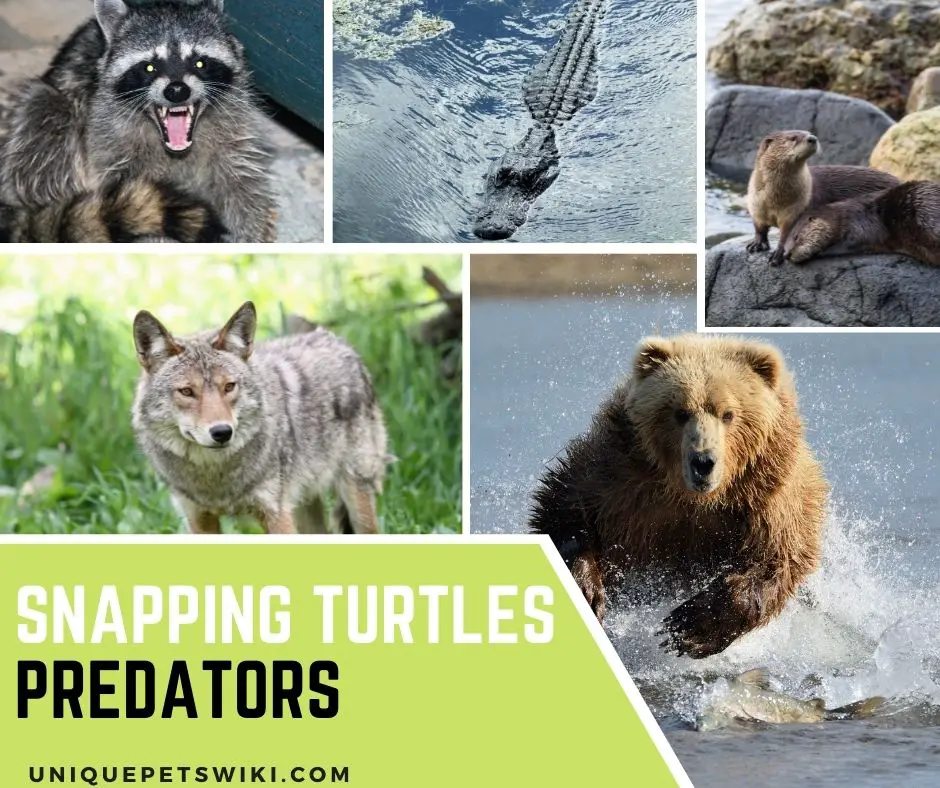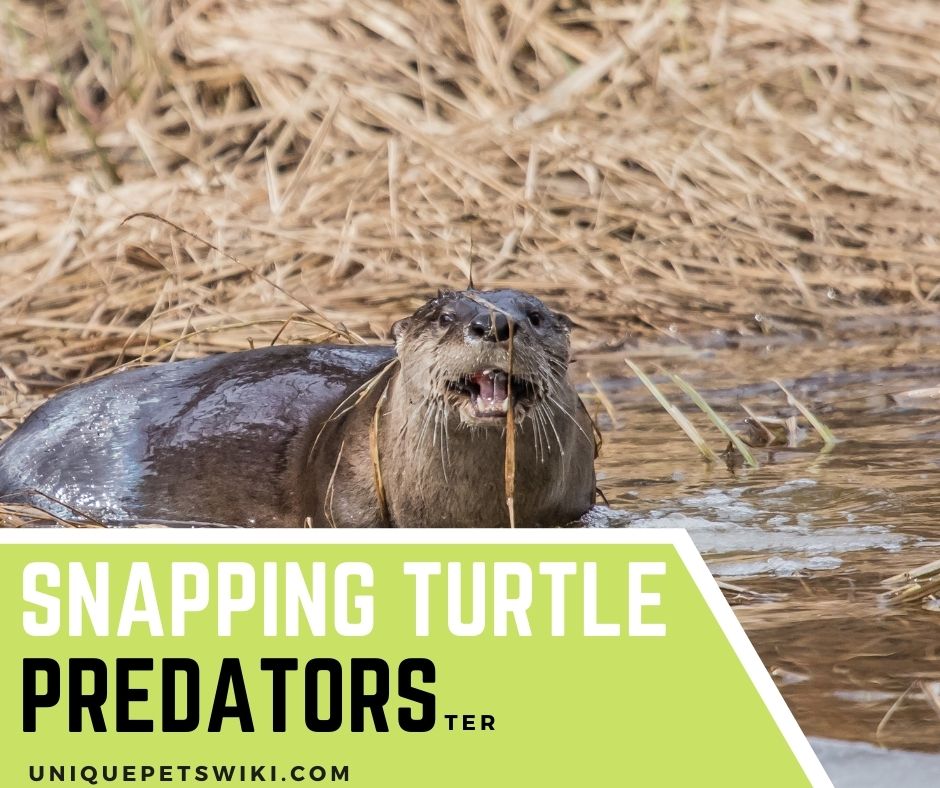Many people know what a snapping turtle is, but they don’t know what their predators are and how we can contribute to protecting these species.
If you are one of these people, then this article is for you as it will talk about the most common predators of snapping turtles at different stages, their relationship to humans, and how humans can help to protect them.
The most common snapping turtle predators are raccoons, alligators, river otters, coyotes, bears, and humans. However, the most dangerous predator is humans because they hunt them to extinction by capturing them with nets or hooks for soup or meat.
Contents
Snapping Turtle Predators: What Are The Predators For Snapping Turtles?
Snapping turtles are always on guard and ready to respond quickly if they’re discovered by a would-be predator. However in water, they usually slip away without causing much of a commotion.
Some common predators are great blue herons, raccoons, striped skunks, red foxes, largemouth bass, bullfrogs, northern water snakes, American crows, etc.
When it comes to the snapping turtle, many predators could kill them. At each stage in their development, these turtles face tough odds and must fight off other animals. Here are the different types of predators:
Predators of Common Snapping Turtle Eggs
The eggs and hatchlings of snapping turtles can be eaten by large turtles, such as the mud turtle. Herons may also eat this animal’s diet if they find it while hunting for other prey items like snails or small fish.
The raccoons often feed upon their leftovers because eating one would mean risking hunger until the next feeding time. They are also preyed upon by foxes, coyotes, skunks, minks, crows, hawks, owls, bullfrogs and snakes.

To protect these eggs, build a cage around them and leave them in place. If moving is necessary, do so carefully, taking great care to keep their right side up to avoid cracks in their shells.
Predators of Baby Snapping Turtle
The diminutive size of baby turtles makes them vulnerable targets for much larger animals.
Common snappers can be preyed on by a range of large and dangerous fish such as largemouth bass, spotted bass (such as mackerel), northern pike muskellunge gar. Semiaquatic serpents include cottonmouths, water snakes; birds also pose threats such as herons, egrets, other mammals: mink river otters raccoons foxes bobcats, etc.
The baby snapping turtles need protection from predatory species like those mentioned above because their small size makes them easy targets for larger, fiercer predators.
Predators of Adult Snapping Turtle
Adult snapping turtles are usually safe from predators, but sometimes they’re attacked by river otters and bears. In the southern United States where their territory overlaps with an American alligator or crocodile (depending on what type you have), these water-dwelling creatures can be preyed upon too!
https://youtu.be/KqSEV7GKxGM
Relationship Between Humans And Snapping Turtles
The relationship between humans and snapping turtles is very important because the relationship truly affects both species uniquely. Humans can be categorized as predators to snapping turtles which affects their relationship, but they also have the relationship of being breeders which also contributes to this relationship.
As A Predator
Humans are predators to snapping turtle populations. By hunting for turtle meat, they are reducing turtle numbers every year.
Turtle soup is an example of how humans are also reducing turtle populations through food consumption. The turtle is usually kept alive until the night before it is prepared for cooking.
This means that turtles can be collected from any location and then kept alive for a few days. Thousands of turtles are killed every year because turtle soup is a popular dish.
Other factors are contributing to a decline in the population of snapping turtles, including car crashes. These car crashes can be attributed to many reasons including distracted drivers, speeding, and crossing paths with turtles on the road at night.
This has had a large impact, not only on deceased turtles but also impacting their habitats making them more susceptible to predators such as raccoons and possums.

As A Breeder
The snapping turtle is one of the most sought-after species for display in public aquaria. This is because they have such unique characteristics to choose from. Despite its large size, the snapping turtle is generally considered an easy pet to keep due to its small aquatic requirements and sometimes even outdoor housing.
Things Humans Can Do Help Snapping Turtles
There are many things that humans do that they don’t realize and end up hurting snapping turtles without even knowing it. The following is a list of things that humans can do to help snapping turtles:
Slow Down For Snapping Turtles That Are Crossing Roads
If you want to help a turtle across the road, make sure that it is safe for both yourself and the animal. Look out for cars in your path before taking action so there aren’t any hit-and-run incidents!
To do this safely though, keep them low to the ground by slowly pushing with one hand on top of their shell while looking forward at where they need to go next with the other arm raised above head height if possible (to give more space).
The safest way would be having something like garden tools or even just wearing gloves ready – then use these as pokes when needed.
Do Not Eat Turtles
The snapping turtle is a fascinating and ancient creature, but human consumption of this animal has contributed to the decline of their population.
Overharvesting for their meat has caused the snapping turtle population to dwindle. Some states are now banning their collection from the wild. The species is an endangered one and it needs our help if we want these animals around forever.
Do Not Disturb Snapping Turtles That Are Nesting
Distressed snapping turtles may abandon their nest and try again. They are not aggressive, but they become defensive during nesting season.
Provide Nesting Habitat Near Lakes
To make sure that turtles can find a safe place to nest, provide them with a nesting habitat near lakes and wetlands. These are areas that are free from fish (fish eat snapping turtle eggs) and have a soft bottom for nesting.
Conservation Status Of Snapping Turtle
The populations of snapping turtles are not close to extinction, but they could be at risk for habitat destruction. Some individuals may get killed because it’s an important source of food; however, this only has a minor impact on their numbers overall.
Due to pressure from environmental degradation and pressure from pet collection and trade, snapping turtles are receiving more attention. Several US states and Canada have enacted stricter snapping turtles conservation measures.
The Final Sentences
Snapping turtles are fascinating species of animal. They have adapted to their environment, which means they can be found in the desert or on top of snowy mountains.
This article has discussed what predators might eat snapping turtles and how humans interact with this species. For more information on where you can find these animals check out our blog!
